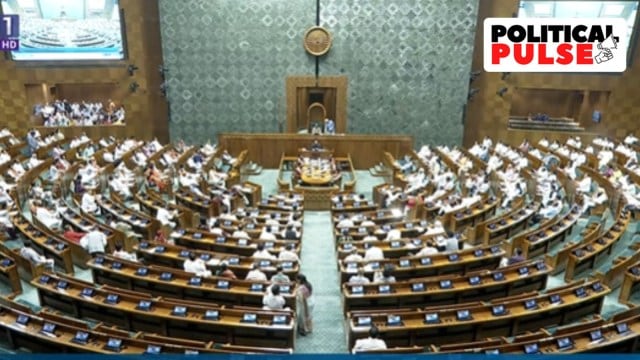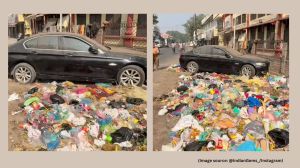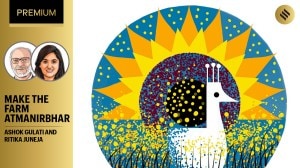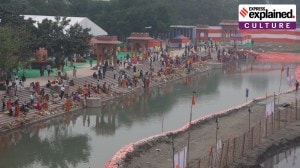As MPs flag ‘ageing’ Parliament, a look at how 18th Lok Sabha is India’s oldest ever
With MPs’ average age of 56, the current LS is oldest so far, just 25 MPs are 35 or younger with more than two-thirds being over 50; the youngest House was recorded in 1998 with MPs’ average age of 46.4
 It’s not the first time that a proposal for lowering the age for contesting polls has been made in Parliament. (File Photo)
It’s not the first time that a proposal for lowering the age for contesting polls has been made in Parliament. (File Photo)In the recent general election, India elected its oldest ever Lok Sabha with the average age of MPs climbing to 56. The disparity between the average age of India’s politicians and its population has become a subject of discussion in Parliament during the ongoing Budget session.
While in the Rajya Sabha Aam Aadmi Party (AAP) MP Raghav Chadha Thursday called for the minimum age to contest elections to be dropped from 25 to 21, Congress MP Shashi Tharoor introduced a private member’s Bill in the Lok Sabha to reserve 10 seats in the Lower House for MPs younger than 35.
Chadha, 35, who raised the matter during special mentions, said the average age of India’s population deserves representation in the House. “At least 65% of our population is below 35 years and 50% below 25 years,” said Chadha, who is himself among the youngest MPs. “When the first Lok Sabha was elected after Independence, 26% of members were below 40 years. When our 18th Lok Sabha was elected two months ago, 12% of the members were below 40 years.”
It’s not the first time that a proposal for lowering the age for contesting polls has been made in Parliament. Last August, the Parliamentary Standing Committee on Personnel, Public Grievances, Law and Justice recommended lowering the minimum age for contesting an Assembly election from 25 years to 18 years.
Age profile of Lok Sabha
The first Lok Sabha, elected in 1952, was the second youngest on record with the average age of MPs at 46.5 years. The first House also had a record 82 MPs aged 40 or under and no MPs older than 70.
 Average age of MPs by Lok Sabha
Average age of MPs by Lok Sabha
Since then, the average age of MPs has risen consistently. In 1998, the average age dipped to the lowest ever at 46.4 years. Prior to the 2024 Lok Sabha polls, the highest average age was recorded after the 1999 elections at 55.5 years. This time, the average age of the MPs in the 18th Lok Sabha hit a record high of 56.
In the current Lok Sabha, there are just 25 MPs under 35, of whom only seven are under 30. Only two previous Lok Sabhas have had fewer MPs below the age of 35 – in 2019 at 21 and in 2009 at 22. The number of MPs aged 35 or less has consistently declined since the first Lok Sabha.
 MPs under 35 by Lok Sabha
MPs under 35 by Lok Sabha
In contrast, there are now 380 MPs who are 51 or older. Of them, as many as 53 are older than 71 years and 161 MPs are aged 61 to 70 years. At 30.6%, the 51-60 age group has the largest representation in the House.
The oldest sitting MP T R Baalu of the DMK has been elected from Tamil Nadu’s Sriperumbudur. At 82, he is the only MP older than 80.
There are three MPs aged 25, the youngest eligible age to contest the Lok Sabha polls – the Samajwadi Party MPs Priya Saroj from Machhlishahr and Pushpendra Saroj from Kaushambi in Uttar Pradesh, and the Lok Janshakti Party (Ram Vilas)’s Shambhavi Choudhary from Samastipur in Bihar.
In comparison with the MPs, the average age of Indians is just 27.8 years old, as per the 2011 Census.
How MPs’ minimum age was decided
The debates in the Constituent Assembly, which drew up the Constitution, suggest several of India’s early leaders were in favour of a lower age requirement for becoming an MP.
Article 84, which sets the eligibility criteria for parliamentarians, was introduced as an amendment to the Draft Constitution in the Constituent Assembly by B R Ambedkar on May 19, 1949. In his provisions, Ambedkar recommended 25 years as the minimum age for the Lower House but set the bar at 35 for the Rajya Sabha.
Ambedkar argued that merely being a voter — whose eligibility criterion was 21 years until 1988 — was not enough to serve in Parliament. Though the minimum age for becoming an MP in the Lok Sabha was accepted, several members of the Constituent Assembly said 35 years was too high a bar in the case of the Rajya Sabha.
G Durgabai, a freedom fighter, feminist and social worker, proposed that the limit for a Rajya Sabha MP be lowered to 30. “Wisdom does not depend on age… Our boys and girls are now more precocious and the educational curriculum is now so broad-based that it will educate them very well in respect of their civic rights and duties. I therefore think we should give a chance to these younger people to be trained in the affairs of the state,” Durgabai said.
Shibban Lal Saxena, an educator and freedom fighter, citing examples of Shankaracharya becoming a scholar at 22 and Alexander the Great’s conquests before turning 25, said, “Our country of 300 million may produce precocious young men fit to occupy the highest positions at an age younger than 25 and they should not be deprived of the opportunity.”
Ambedkar argued in response that reducing the minimum age for the Upper House would be inconsistent with the provision that set the minimum age for the vice-president, who would preside over the Rajya Sabha, at 35. However, he finally agreed to Durgabai’s amendment for a limit of 30 years and, shortly afterwards, it was adopted by the Constituent Assembly. The same criteria of 25 and 30 years for the two Houses were later applied to the state legislatures as well.



- 01
- 02
- 03
- 04
- 05




























